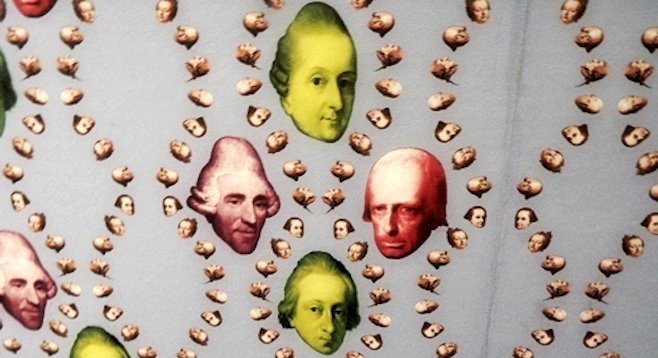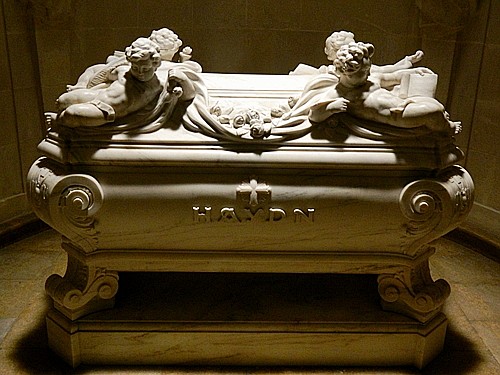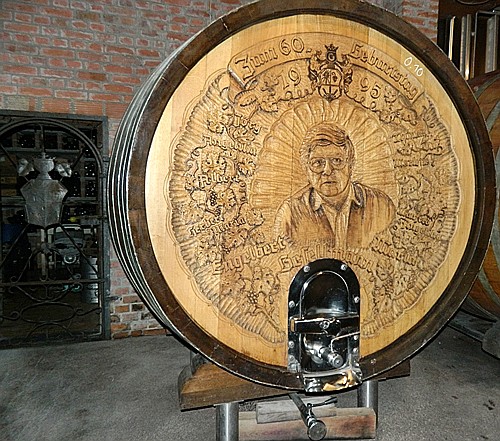 Facebook
Facebook
 X
X
 Instagram
Instagram
 TikTok
TikTok
 Youtube
Youtube

Many people are largely unfamiliar with how important Franz Joseph Haydn was to classical music. He is called the “Father of the Symphony” and “Father of the String Quartet,” yet he is not as well known in popular culture as his friend Mozart or his student Beethoven.
Haydn lived and worked in the Burgenland region of Austria, a beautiful part of the planet that at times belonged to Hungary. Since he was isolated from places like Vienna, his musical style evolved without outside influence.
The composer spent most of his career employed as a court musician for the noble Esterhazy family. Prince Esterhazy had two palaces, one of which is in Eisenstadt.
Eisenstadt hosts the Haydn Festival, which is a perfect time to immerse oneself in all things Haydn.
Haydn’s music, life and death. Joseph Haydn’s home in Eisenstadt is now a museum. It’s interesting to see how his insecurities about being essentially a servant to the Esterhazy family played into the decoration of his home.
He lost some art in a house fire; he then had the place decorated in framed manuscripts of his music. He commissioned trompe l’oeil murals to mimic the look of the carved marble and wainscoting in his employer’s home. He made sure to supply his wife with the latest in culinary tools – though of course the Esterhazy women would never have been seen working in a kitchen.
There are guided tours through the Esterhazy Palace, including the specially created organ for Haydn as well as the chapel and auditorium where his music was first heard. (Clip of a trumpet serenade before the Haydn Festival concert below.)
The spectacular “Haydn Explosiv” exhibit is also on the palace grounds. Though created for local schoolchildren to learn about the master, it combines awesome pop culture elements – holograms, light shows, the Warholesque wallpaper of Franz West, carpeting by artist Roy Lichtenstein, interactive music – to delight adults perhaps even more.
You can’t just watch Haydn in a museum. You have to hear his music in concert! The Haydn Festival takes place every September, with each year revolving around a different theme. However, special Haydn concerts take place throughout the year as well. The performances are in the gorgeously decorated Haydn Hall, just as they were during his lifetime. The acoustics and orchestral specifications are true to the classical style.

Haydn was involved in a real-life mystery after he died. Phrenologists severed his genius skull to help support their medical theories and kept it for nearly 150 years. They masked their crime by placing another skull in his crypt. A 20th-century Esterhazy prince wanted to honor the long-time servant of his family and arranged for Haydn’s skull to be returned after WWII. Now two skulls are buried in Haydn’s tomb in Eisenstadt.
Eating and drinking, Haydn style. Haydn not only enjoyed wine, he accepted some of the Prince’s Blaufrankische wines as part of his annual payment.
Vinatrium is a wine shop that focuses on the region’s wines: for 10 Euros, you can taste as many as you like of the hundreds of wines for as long as you like! I saw the local television studio personnel doing a very leisurely teambuilding workshop there.
One of the participating vintners has a wonderful vineyard worth visiting on its own: K+K Kirnbauer. Their wines are luscious, the views from the tasting room’s porch are stunning and they put out gourmet snacks.
Velich is one of the wineries taking advantage of the latest in “wine architecture” to offer a delightful tasting experience. They're in the Seewinkle area of Burgenland, and the salty air gives fabulous local flair and flavor to their wines.

Gesellmann is a family-owned winery that has some wines marketed to the U.S. They take their work seriously!
The Imperial wines of Schloss Halbturn are still produced by Austrian nobility on their estate. They offer overnight accommodations and special event space, too.
The Heinrich family has been making wines for hundreds of years: the daughter of the family is taking things into the future with sparkling varietals for fun days, drinkable reds and more. They have a little shed on top of their vineyard where you can drink, as well as very unusual overnight accommodations inside the winery itself.
Tschida has won the Sweet Winemaker of Austria award, and any visit to their winery is an education that will transform your idea of how sophisticated the drink can be. The key is an acidic balance to the sweet.
Across the road from the Esterhazy palace entrance, in what used to be the Prince’s riding stables, is Weinwerk , an exclusively Burgenland wine bar with over 40 changing wines available by the glass, and Henrici, an upscale bistro with outdoor seating amidst ancient columns.
Paprikawirten in Frauenkirchen is located in what was the Esterhazy hunting lodge. They serve local beers, wines, housemade jams, pepper jellies, seasonal local fish and game. It’s a casual, tavern atmosphere with delicious Hungarian-style recipes.
Where to stay. Bleim’s Wohn Reich is a family-run, totally chic and sleek boutique hotel crafted out of a 150-year-old wine house. Wild herbs grow in the courtyard, where at night the rooms are lit up with a rainbow of neon window lights. Rooms have a fun white futuristic design, but with all the comforts of home.
At breakfast (which they have the sophistication to serve later into the day), you’ll find a wonderful buffet of the neighbor’s eggs, house-made jams, locally produced meats and cheeses, and organic juices.
I also learned about a very nice Burgenland tradition: wine at breakfast! They like a clean, crisp, light white wine at a leisurely breakfast, much like our brunch Mimosa tradition.


Many people are largely unfamiliar with how important Franz Joseph Haydn was to classical music. He is called the “Father of the Symphony” and “Father of the String Quartet,” yet he is not as well known in popular culture as his friend Mozart or his student Beethoven.
Haydn lived and worked in the Burgenland region of Austria, a beautiful part of the planet that at times belonged to Hungary. Since he was isolated from places like Vienna, his musical style evolved without outside influence.
The composer spent most of his career employed as a court musician for the noble Esterhazy family. Prince Esterhazy had two palaces, one of which is in Eisenstadt.
Eisenstadt hosts the Haydn Festival, which is a perfect time to immerse oneself in all things Haydn.
Haydn’s music, life and death. Joseph Haydn’s home in Eisenstadt is now a museum. It’s interesting to see how his insecurities about being essentially a servant to the Esterhazy family played into the decoration of his home.
He lost some art in a house fire; he then had the place decorated in framed manuscripts of his music. He commissioned trompe l’oeil murals to mimic the look of the carved marble and wainscoting in his employer’s home. He made sure to supply his wife with the latest in culinary tools – though of course the Esterhazy women would never have been seen working in a kitchen.
There are guided tours through the Esterhazy Palace, including the specially created organ for Haydn as well as the chapel and auditorium where his music was first heard. (Clip of a trumpet serenade before the Haydn Festival concert below.)
The spectacular “Haydn Explosiv” exhibit is also on the palace grounds. Though created for local schoolchildren to learn about the master, it combines awesome pop culture elements – holograms, light shows, the Warholesque wallpaper of Franz West, carpeting by artist Roy Lichtenstein, interactive music – to delight adults perhaps even more.
You can’t just watch Haydn in a museum. You have to hear his music in concert! The Haydn Festival takes place every September, with each year revolving around a different theme. However, special Haydn concerts take place throughout the year as well. The performances are in the gorgeously decorated Haydn Hall, just as they were during his lifetime. The acoustics and orchestral specifications are true to the classical style.

Haydn was involved in a real-life mystery after he died. Phrenologists severed his genius skull to help support their medical theories and kept it for nearly 150 years. They masked their crime by placing another skull in his crypt. A 20th-century Esterhazy prince wanted to honor the long-time servant of his family and arranged for Haydn’s skull to be returned after WWII. Now two skulls are buried in Haydn’s tomb in Eisenstadt.
Eating and drinking, Haydn style. Haydn not only enjoyed wine, he accepted some of the Prince’s Blaufrankische wines as part of his annual payment.
Vinatrium is a wine shop that focuses on the region’s wines: for 10 Euros, you can taste as many as you like of the hundreds of wines for as long as you like! I saw the local television studio personnel doing a very leisurely teambuilding workshop there.
One of the participating vintners has a wonderful vineyard worth visiting on its own: K+K Kirnbauer. Their wines are luscious, the views from the tasting room’s porch are stunning and they put out gourmet snacks.
Velich is one of the wineries taking advantage of the latest in “wine architecture” to offer a delightful tasting experience. They're in the Seewinkle area of Burgenland, and the salty air gives fabulous local flair and flavor to their wines.

Gesellmann is a family-owned winery that has some wines marketed to the U.S. They take their work seriously!
The Imperial wines of Schloss Halbturn are still produced by Austrian nobility on their estate. They offer overnight accommodations and special event space, too.
The Heinrich family has been making wines for hundreds of years: the daughter of the family is taking things into the future with sparkling varietals for fun days, drinkable reds and more. They have a little shed on top of their vineyard where you can drink, as well as very unusual overnight accommodations inside the winery itself.
Tschida has won the Sweet Winemaker of Austria award, and any visit to their winery is an education that will transform your idea of how sophisticated the drink can be. The key is an acidic balance to the sweet.
Across the road from the Esterhazy palace entrance, in what used to be the Prince’s riding stables, is Weinwerk , an exclusively Burgenland wine bar with over 40 changing wines available by the glass, and Henrici, an upscale bistro with outdoor seating amidst ancient columns.
Paprikawirten in Frauenkirchen is located in what was the Esterhazy hunting lodge. They serve local beers, wines, housemade jams, pepper jellies, seasonal local fish and game. It’s a casual, tavern atmosphere with delicious Hungarian-style recipes.
Where to stay. Bleim’s Wohn Reich is a family-run, totally chic and sleek boutique hotel crafted out of a 150-year-old wine house. Wild herbs grow in the courtyard, where at night the rooms are lit up with a rainbow of neon window lights. Rooms have a fun white futuristic design, but with all the comforts of home.
At breakfast (which they have the sophistication to serve later into the day), you’ll find a wonderful buffet of the neighbor’s eggs, house-made jams, locally produced meats and cheeses, and organic juices.
I also learned about a very nice Burgenland tradition: wine at breakfast! They like a clean, crisp, light white wine at a leisurely breakfast, much like our brunch Mimosa tradition.
Comments